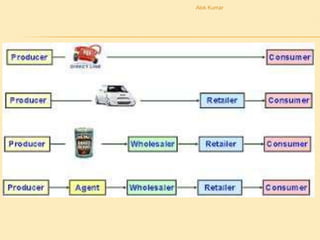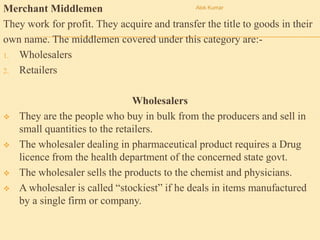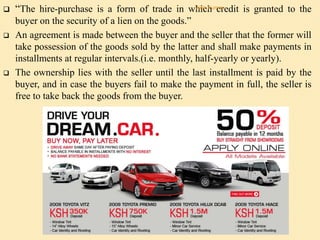Chennal of distribution
- 1. Alok Kumar
- 2. CHANNELS OF DISTRIBUTION Channel of distribution is the path through which products move from the place of production to the place of ultimate consumption. It is the connecting link between the producer and the consumer to sell the products. It creates the utilities of time, place and possession by bridging the gap between the point of production and the point of consumption. The distribution channels divided in to two parts:- Direct Selling Indirect Selling Alok Kumar
- 3. Direct Selling:- Manufacturer Consumer Alok Kumar
- 4. Indirect Selling:- Manufacturer Retailer Consumer Manufacturer Retailer ConsumerWholesaler RetailerDistributorManufacturer Wholesaler Consumer Alok Kumar
- 5. Alok Kumar
- 6. TYPES OF MIDDLEMEN The middlemen are the persons who act as link between the Producer & Consumer. There are two types of Middlemen:- 1- Functional Middlemen 2- Merchant Middlemen 1- Functional Middlemen:- The functional middlemen are those intermediaries who perform various marketing function without having any title to goods e.g. they help in transfer of good from the hands of the producer to those consumers without acquiring any ownership rights. The following middlemen comes under this category:- I. Brokers II. Commission agents III. Auctioneers IV. Del Credere agents Alok Kumar
- 7. Merchant Middlemen They work for profit. They acquire and transfer the title to goods in their own name. The middlemen covered under this category are:- 1. Wholesalers 2. Retailers Wholesalers They are the people who buy in bulk from the producers and sell in small quantities to the retailers. The wholesaler dealing in pharmaceutical product requires a Drug licence from the health department of the concerned state govt. The wholesaler sells the products to the chemist and physicians. A wholesaler is called “stockiest” if he deals in items manufactured by a single firm or company. Alok Kumar
- 8. Form 19 For Retail drug Store Form 19 For Wholesale drug Store Alok Kumar
- 9. Alok Kumar
- 10. Classification of Wholesalers 1) Manufacturer Wholesalers 2) Retailer Wholesalers 3) Wholesalers Proper or Pure Wholesalers 1. Manufacturer Wholesalers:- These wholesalers engage themselves in manufacturing activities to some extent. They also purchase the goods of other manufacturers and sell them along with their own products. In this manner they increase their turnover and considerably reduce selling and overhead expenses. 2. Retailer Wholesalers: They purchase goods in large quantities from the manufacturers and sell them directly to the consumers by opening their own retail shops. In this manner they simultaneously act as wholesalers and retailers. Alok Kumar
- 11. 3. Wholesalers Proper or Pure Wholesalers They are known as pure wholesalers’ as they concentrate fully on wholesale activities. They neither manufacture nor retail goods directly to consumers. They purchase goods in large quantities from different manufacturers and supply to retailers in small lots. They engage their own vans or vehicles in order to distribute goods to the retailers. They are also known as “Distributors” Alok Kumar
- 12. Wholesaler Functions 1. Assembling: A wholesaler buys the products from different manufacturers and keeps them in one place. 2. Storage: There is usually a large time gap between the production and consumption of goods. The wholesaler maintains demand/supply stability by storing a stock of goods with them and delivering the required amount to the retailers whenever required. 3. Distribution: A wholesaler distributes the assembled and stored goods to a large number of retailers operating in different places. 4. Transportation: Wholesalers usually handle the transportation of goods from their warehouses to retail shops. 5. Financing: Transactions between wholesalers and retailers are usually made on a credit basis where the wholesaler provides certain credit to maintain good relations with the retailers. He also usually buys the goods on a cash basis from the manufacturer to finance them. Alok Kumar
- 13. 7. Risk-Bearing: Wholesalers take the responsibility of damaged goods during transit and storage. Since he stocks a large number of goods, he also bears the risk of loss due to fluctuation demand. 8. Grading and Packing: Many wholesalers classify the assembled goods into different grades, pack them into small lots and put their own trademarks or brand names. In this way, they perform the functions of grading, packing and branding. 9. Market research: One of the most important functions of wholesaler is that he provides important market information to retailer and manufacturer. This information helps the retailers to estimate the demand of consumer. It also helps manufacturer, produce the goods according to the change in the tastes and fashions of the consumer. Alok Kumar
- 14. RETAILERS Retailers are the traders who buy goods from wholesalers or sometimes directly from producers and sell them to the consumers. They usually operate through a retail shop and sell goods in small quantities. They keep a variety of items of daily use. Alok Kumar
- 15. Characteristics of Retailers The following are the characteristics of retailers: Retailers have a direct contact with consumers. They know the requirements of the consumers and keep goods accordingly in their shops. Retailers sell goods not for resale, but for ultimate use by consumers. For example, you buy fruits, clothes, pen, pencil etc. for your use, not for sale. Retailers buy and sell goods in small quantities. So customers can fulfill their requirement without storing much for the future. Retailers require less capital to start and run the business as compared to wholesalers. Retailers generally deal with different varieties of products and they give a wide choice to the consumers to buy the goods. Functions of Retailers 1. Buying and Assembling of goods: Retailers buy and assemble varieties of goods from different wholesalers and manufacturers. They keep goods of those brands and variety which are liked by the customers and the quantity in which these are in demand. Alok Kumar
- 16. 2. Storage of goods: To ensure ready supply of goods to the customer retailers keep their goods in stores. Goods can be taken out of these store and sold to the customers as and when required. This saves consumers from botheration of buying goods in bulk and storing them. 3. Credit facility: Although retailers mostly sell goods for cash, they also supply goods on credit to their regular customers. Credit facility is also provided to those customers who buy goods in large quantity. 4. Personal services: Retailers render personal services to the customers by providing expert advice regarding quality, features and usefulness of the items. They give suggestions considering the likes and dislikes of the customers. They also provide free home delivery service to customers. Thus, they create place utility by making the goods available when they are demanded. 5. Risk bearing: The retailer has to bear many risks, such as risk of: (a) fire or theft of goods (b) deterioration in the quality of goods as long as they are not sold out. (c) change in fashion and taste of consumers. 6. Display of goods: Retailers display different types of goods in a very systematic and attractive manner. It helps to attract the attention of the customers and also facilitates quick delivery of goods. 7. Supply of information: Retailers provide all information about the behavior, tastes, fashions and demands of the customers to the producers through wholesalers. They become a very useful source of information for marketing research. Alok Kumar
- 17. Types of Retailers Small-scale Retail: Trade There are verities of retailers engaged in small scale retail trading. They can be classified as: (i) Itinerant Retailing (ii) Fixed Shop Retailing Alok Kumar
- 18. 1. Itinerant Retailing Itinerant retailing is a type of small-scale retail trade in which retailers move around and sell a variety of items directly to the consumers. They do not have a fixed shop where they can sell. You must have seen them distributing newspapers early in the morning, selling peanuts, bangles, toys etc. in buses and trains; selling fruits and vegetables in your locality using a cart, selling ice-cream, namkeens etc. on a cycle, selling rice, earthen pots or even carpets by using a cart, etc. Alok Kumar
- 19. 2. Fixed Shop Retailing Here the retailers sell goods and services from a fixed place known as ‘shop’. These shops are usually located at market places or commercial areas or near residential localities. These shops normally deal with a limited variety of goods. The goods are stored as well as displayed in the shops. On the basis of the type of goods which the fixed shops deal in , we can classify this form of retailing as under. a. General store or variety store b. Single line store c. Specialty store. General store or variety store Single line store Specialty store Alok Kumar
- 20. Large-scale Retail Departmental Store:- A departmental store is a big store engaged in the retail trade under the same roof. There may be separate departments for cloths, readymade garments, books, medicines, groceries. etc. Alok Kumar
- 21. Multiple Shops: It consist of a chain of store in a city, throughout the state/country and are organised by a centralized agency for selling the same kind of products. Ex. Multiple shops are Bata, D.C.M, Usha etc. Alok Kumar
- 22. Alok Kumar
- 23. Alok Kumar
- 25. MEANING Mail order houses are the retail outlets that sell their merchandise through mail. The seller’s offer is made through mass mailing of a circular or catalog or through an advertisement placed in a newspaper or magazine and in which the buyer places an order by mail. Delivery of the goods may be made by freight, express, or parcel post on a cash-on-delivery basis. Alok Kumar
- 26. Types of Mail order business 1. The Manufacturing Mail Order Houses 2. Departmental Mail Order House 3. Middlemen Mail Order House The Manufacturing Mail Order Houses This type of mail order house is set up by the manufacturer himself in order to sell the goods to the customers directly by mail. The Middlemen are eliminated. Departmental Mail Order House This is also known as mail order business of the departmental store. Most of the departmental stores operate a separate mail order section which supplies goods to the customers by mail on receiving their orders. Middlemen Mail Order House These are also known as the mail order house proper. They do not manufacture the goods themselves but purchase directly from the wholesalers or manufacturer for supplying them to customers by post. Alok Kumar
- 27. Alok Kumar
- 28. PROCEDURE 1. PREPARATION OF THE MAILING LIST The first step is the preparation of mailing list of potential customers from telephone directories, list of members of club or trade association. 2.APPROACH TO CUSTOMERS sellers approach customers through advertisement in newspapers, magazines, circulars etc. All the relevant information about the product such as price,features,delivery terms, terms of payment are informed. 3. RECEIVING OF ORDERS Customers send their orders by post. Orders received are entered in the order received book. 4. DISPATCH OF GOODS Goods are verified to ensure that they meet the buyers specifications. they are properly packed and delivered to post office. Alok Kumar
- 29. 5. MODE OF PAYMENT Different alternatives for receiving payments Making full payment: Value payable post: goods may be sent by the VPP in which goods are sent through post and are delivered to the customers only when the full payment is made. Payment through bank: goods may be sent through a bank which is instructed to deliver the goods only when the customer makes full payment. Alok Kumar
- 30. Alok Kumar
- 31. Advantages of mail order business: Mail order system offers the following advantages. They are 1) Less capital Requirement 2) A wide market 3) Unusual buying power 4) No risks of bad debts 5) Efficient use of capital 6) Managerial specialization; and 7) Consumer convenience. 8) The buyers generally given money back guarantee. 9) No need to storing the goods. 10) No need to appointing middlemen. Alok Kumar
- 32. Disadvantages or Limitations of mail order business Mail order business suffers from the following limitations: 1) There is lack of personal contact between the seller and the buyer. It cannot meet the unexpected objections raised by customers. 2) It cannot give personal advice and assurance that the goods sold by mail will satisfy the requirements of customers. 3) There is scope for fraud, inconvenience due to delay, misunderstanding of customers, etc. 4) Mail order houses are confronted with the problems of numerous correspondence, customer complaints, damage in transit, return of articles, excessive operating cost, credit policies, etc. 5) In mail order business, wide distribution of catalogues is essential. Colorful catalogues are expensive and are to be printed in advance. Supplementary catalogues will have to be issued to announce price changes and new offers. 6) Buyers have to rely wholly upon catalogues to know about the goods. They cannot inspect the goods before buying them. Alok Kumar
- 33. 7) After sale service is not extended to customers. 8) Sometimes, the mail order houses charge high prices for the articles sold. 9) Articles requiring demonstration cannot be sold by mail. 10) Lots of money spent on advertisements. Alok Kumar
- 35. “The hire-purchase is a form of trade in which credit is granted to the buyer on the security of a lien on the goods.” An agreement is made between the buyer and the seller that the former will take possession of the goods sold by the latter and shall make payments in installments at regular intervals.(i.e. monthly, half-yearly or yearly). The ownership lies with the seller until the last installment is paid by the buyer, and in case the buyers fail to make the payment in full, the seller is free to take back the goods from the buyer. Alok Kumar
- 36. Type of goods sold under Hire-Purchase System: 1) Goods which are costly and for which the buyer cannot make the total payment at once. 2) The article should be of the type which can be easily got back in case of default in payment by the buyer. 3) The goods should be of a standard quality so that it can be re-sold, if necessary. 4) The demand for the product should be stable. 5) The article should be of a durable nature. Alok Kumar
- 37. Features of hire purchase agreement The Hire purchase agreement serves as the basis of Hire Purchase Financing Following are some of the feature: a) Under hire purchase system the buyer takes possession of goods immediately and agrees to pay the total hire purchase price in installments. b) Each installment is treated as hire charges. c) The ownership of the goods passes from the seller to the buyer on the payment of the installment. d) In case the buyer makes any default inthe payment of any installment the seller has the right to possess the goods from the buyer and forfeit the amount already received treating it as hire charges. e) Most noteworthy, the seller has the option to return the goods. In this case, he need not pay installments falling due after that. Alok Kumar
- 38. Advantages: 1) Enables people with limited income to buy goods of their choice and wish. 2) Helpful for small-scale manufacturers. 3) Since goods are sold on installment basis, it helps in increasing trade. 4) It develops a habit of thrift amongst people since they have to save some part of their income to pay off the installments. 5) This system is very helpful to salaried class of people. Disadvantages: i) People usually purchase items of luxury, thus straining their resources. ii) The inclusion of interest in installments increases the total cost of the product for the buyer. iii) Leads to losses for sellers because of default in payment by buyer. iv) The traders dealing in hire purchase system have to arrange a large capital to run the business. Alok Kumar
- 40. Meaning A consumer co-operative is a retail business which is owned by the consumers themselves. Their basic objective is to eliminate middlemen. The consumers join together and manage the business and the profit thus earned is retained among themselves in the proportion of their contribution. The society purchases in bulk and avails the discounts and sells in small lots to the members. Characteristics It is a voluntary association of persons and is registered under the Co-operative Societies Act, which extends certain privileges and grants certain exemptions to a registered society. Such societies sell for cash and seldom allow credit facilities. The liability of members is limited to the extent of their contribution. Alok Kumar
- 41. Democratic control is exercised. The purchases are made in bulk, thus enjoying economies of large scale purchasing. The prices of commodities sold by such societies are fixed. The profit earned by the society is distributed among the members and also spent on general welfare measures. Alok Kumar
- 42. Advantages: The purchases are made in bulk and hence trade discounts are available to such societies. The control is democratic and no single group can secure control over the organisation. Less advertisement expenses are incurred. It makes members feel the sense of belongingness to the society. Profits earned are not spent on unproductive investments. Disadvantages: The societies have very limited resources so these stores cannot run on large scale. All the members of the society may not be co-operative and responsible hence these tend to suffer financial losses. As the capital can be withdrawn by the members at any time, this is greatly harmful during the periods of depression and slackness of business activities. Alok Kumar
- 43. Alok Kumar










































